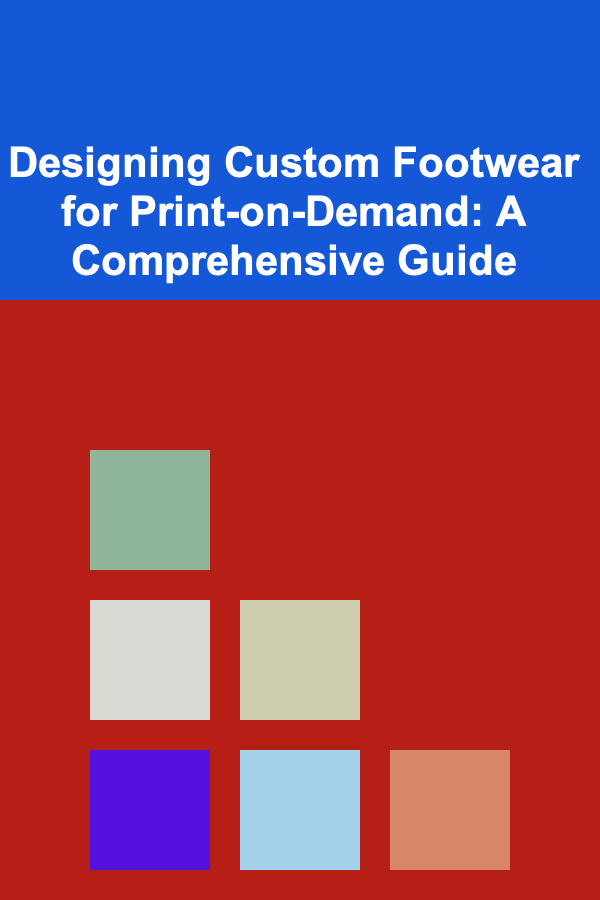
Designing Custom Footwear for Print-on-Demand: A Comprehensive Guide
ebook include PDF & Audio bundle (Micro Guide)
$12.99$10.99
Limited Time Offer! Order within the next:

Print-on-demand (POD) footwear offers a fantastic opportunity to unleash creativity and cater to niche markets without the burden of large upfront investments in inventory. However, success in this field requires a strategic approach that encompasses understanding the market, mastering design tools, optimizing designs for print, and navigating the complexities of the POD fulfillment process. This comprehensive guide will delve into each of these areas, providing you with the knowledge and insights necessary to design and sell compelling custom footwear.
Understanding the Print-on-Demand Footwear Landscape
Before diving into design, it's crucial to grasp the intricacies of the POD footwear market. This involves recognizing the available product types, understanding target audiences, and staying abreast of current trends.
Footwear Product Types
The POD footwear market encompasses a variety of shoe types, each with its own design considerations and target audience. Common options include:
- Sneakers: A versatile option popular for everyday wear and athletic activities. Design complexity can range from simple all-over prints to intricate patterns and custom branding.
- Canvas Shoes: A classic and affordable option often favored for casual wear. Typically offers a larger printable surface area.
- Slip-Ons: Easy-to-wear and customizable with bold patterns and graphics. Often a lower price point, making them attractive to budget-conscious buyers.
- Boots: More specialized and often catering to specific aesthetics (e.g., punk, goth, urban). Design considerations include shaft height, material texture, and hardware placement.
- Sandals/Flip-Flops: Ideal for summer and beachwear, offering opportunities for vibrant designs and personalized messages.
- Slippers: Focus on comfort and can be customized with cozy materials and playful designs.
Identifying Your Target Audience
Defining your target audience is paramount to creating designs that resonate and drive sales. Consider the following factors:
- Demographics: Age, gender, location, income level, and education.
- Interests: Hobbies, passions, lifestyle, and affiliations.
- Style Preferences: Fashion trends, color palettes, and design aesthetics.
- Needs and Pain Points: What problems can your designs solve? Are they seeking comfort, style, or a specific functional feature?
By understanding your target audience, you can tailor your designs to their specific preferences and create compelling marketing messages that capture their attention. For example, designs targeting skateboarders will differ significantly from those targeting yoga enthusiasts.
Staying Ahead of Trends
The fashion industry is constantly evolving, so it's essential to stay informed about current trends. Utilize resources such as:
- Fashion Blogs and Magazines: Stay updated on the latest styles and trends.
- Social Media: Follow influential designers, brands, and fashion personalities.
- Trend Forecasting Websites: Access in-depth analysis of upcoming trends.
- Online Marketplaces: Analyze best-selling products and customer reviews to identify emerging patterns.
While following trends is important, it's also crucial to develop your own unique style and perspective. Authenticity and originality can help you stand out from the competition and build a loyal customer base.
Mastering Design Tools and Techniques
Creating visually appealing and print-ready designs requires proficiency in relevant design tools and techniques. Several options are available, ranging from free online editors to professional-grade software.
Software Options
- Adobe Photoshop: Industry-standard for photo editing and raster graphics. Excellent for creating detailed designs, manipulating images, and preparing files for print.
- Adobe Illustrator: Ideal for creating vector graphics, logos, and illustrations. Scalable designs without loss of quality, perfect for complex patterns and typography.
- GIMP (GNU Image Manipulation Program): A free and open-source alternative to Photoshop, offering a wide range of features for image editing and design.
- Inkscape: A free and open-source alternative to Illustrator, suitable for creating vector graphics and illustrations.
- Canva: A user-friendly online design tool with a vast library of templates and graphics. Suitable for creating simple designs and marketing materials.
The best software for you will depend on your skill level, budget, and design requirements. Consider trying out free trials or using free versions of software to determine which tools best suit your workflow.
Understanding Print Templates
Most POD providers offer specific print templates for their footwear products. These templates outline the printable areas and provide guidelines for creating designs that align properly with the shoe's construction. Key considerations include:
- Print Area Boundaries: Ensure that your design elements stay within the designated printable areas to avoid cropping or distortion.
- Resolution Requirements: Use high-resolution images (typically 300 DPI) to ensure sharp and clear prints.
- Color Profiles: Use the correct color profile (typically sRGB or CMYK, depending on the POD provider) to ensure accurate color reproduction.
- Bleed Areas: Extend your design slightly beyond the printable area to prevent white edges after printing and cutting.
Always download and carefully review the print templates provided by your chosen POD provider before starting your design. Failure to adhere to these guidelines can result in unsatisfactory print results.
Design Principles for Footwear
Applying fundamental design principles is crucial for creating visually appealing and marketable footwear designs. Consider the following:
- Balance: Create a sense of visual equilibrium by distributing design elements evenly across the shoe's surface.
- Contrast: Use contrasting colors, shapes, and textures to create visual interest and highlight key elements.
- Emphasis: Draw attention to specific areas of the shoe by using focal points, such as a bold graphic or a unique color combination.
- Unity: Create a cohesive design by using a consistent style, color palette, and theme.
- Rhythm and Pattern: Use repetition and variation to create visual movement and interest. Be mindful of how patterns will wrap around the shoe's contours.
Design Techniques Specific to Footwear
Designing for footwear presents unique challenges due to the curved and three-dimensional nature of the product. Consider these techniques:
- All-Over Prints: Create seamless patterns that wrap around the entire shoe. Requires careful planning and attention to detail to avoid distortions.
- Panel-Specific Designs: Design individual panels of the shoe separately and then assemble them digitally to visualize the final result.
- Text Placement: Consider the placement and size of text elements to ensure readability and visual appeal. Avoid placing text across areas that will be distorted by the shoe's construction.
- Utilizing Shoe Anatomy: Integrate design elements with the shoe's existing features, such as the laces, sole, or stitching.
- Mockups: Use 3D mockups to visualize your designs on the shoe and ensure that they look as intended. Many POD providers offer mockup generators.
Optimizing Designs for Print
Optimizing your designs for print is crucial for ensuring high-quality results and minimizing production errors. This involves paying attention to resolution, color profiles, and file formats.
Resolution and Image Quality
As mentioned earlier, using high-resolution images is essential for sharp and clear prints. Aim for a resolution of at least 300 DPI (dots per inch). Low-resolution images will appear pixelated and blurry when printed.
When working with raster graphics (e.g., photos), ensure that the original image is of sufficient quality. Avoid scaling up low-resolution images, as this will only exacerbate the pixelation.
For vector graphics, resolution is less of a concern, as they can be scaled infinitely without loss of quality. However, ensure that any embedded raster images within your vector designs are also of sufficient resolution.
Color Management
Accurate color reproduction is crucial for ensuring that your printed designs match your digital designs. Use the correct color profile (typically sRGB or CMYK, depending on the POD provider) and calibrate your monitor to ensure accurate color representation.
Be aware that colors may appear slightly different on different monitors and when printed. It's a good idea to order a sample print to verify the color accuracy of your designs.
File Formats
The most common file formats for print-on-demand footwear designs are:
- JPEG: A widely supported format for raster graphics, suitable for designs with photographs or complex color gradients. Use a high-quality setting to minimize compression artifacts.
- PNG: A lossless format for raster graphics, ideal for designs with transparent backgrounds or sharp lines.
- PDF: A versatile format that can contain both vector and raster graphics, suitable for complex designs with multiple elements.
- AI (Adobe Illustrator): The native file format for Adobe Illustrator, ideal for vector graphics.
- PSD (Adobe Photoshop): The native file format for Adobe Photoshop, ideal for raster graphics.
Always check with your chosen POD provider to determine their preferred file format. Providing the correct file format will help to ensure a smooth and efficient printing process.
Testing and Mockups
Before launching your designs, it's essential to test them thoroughly and create realistic mockups to showcase them to potential customers. Consider the following:
- Sample Prints: Order sample prints of your designs to verify the print quality, color accuracy, and overall appearance.
- 3D Mockups: Use 3D mockup generators to visualize your designs on the shoe from different angles. This will help you to identify any potential issues and make necessary adjustments.
- Lifestyle Mockups: Create lifestyle mockups that show your shoes being worn in realistic settings. This will help to showcase the shoes' style and appeal to potential customers.
High-quality mockups are crucial for attracting customers and driving sales. Invest time and effort in creating visually appealing and informative mockups that accurately represent your products.
Navigating the Print-on-Demand Fulfillment Process
Understanding the POD fulfillment process is essential for managing customer expectations and ensuring a smooth and efficient order fulfillment process. This involves understanding order processing, production times, shipping, and customer service.
Order Processing
When a customer places an order, the order is automatically routed to your chosen POD provider. The provider then processes the order, prepares the design for printing, and schedules the production.
Familiarize yourself with your POD provider's order processing procedures and any associated fees. Some providers may charge additional fees for rush orders or custom packaging.
Production Times
Production times can vary depending on the POD provider, the complexity of the design, and the order volume. Typically, footwear production times range from a few days to a week or more.
Be transparent with your customers about estimated production times. Provide realistic delivery estimates to avoid disappointment and manage expectations.
Shipping
Once the shoes are produced, they are shipped directly to the customer by the POD provider. Shipping times can vary depending on the destination and the shipping method selected.
Offer a variety of shipping options to cater to different customer needs and budgets. Provide tracking information to customers so they can monitor the progress of their orders.
Customer Service
While your POD provider handles the production and shipping, you are ultimately responsible for providing customer service. Respond promptly to customer inquiries, address any issues or concerns, and handle returns and exchanges.
Build a strong relationship with your POD provider to ensure that they can effectively support your customer service efforts. Clear communication and collaboration are essential for resolving issues and ensuring customer satisfaction.
Choosing the Right Print-on-Demand Provider
Selecting the right POD provider is a critical decision that will impact the quality of your products, the speed of fulfillment, and the overall profitability of your business. Consider the following factors when choosing a provider:
- Product Quality: Request samples from different providers to assess the quality of their footwear products. Pay attention to the materials, construction, and print quality.
- Pricing: Compare pricing across different providers to find the best balance between quality and cost. Factor in production costs, shipping fees, and any additional charges.
- Product Range: Choose a provider that offers a wide range of footwear options to cater to your target market.
- Print Options: Ensure that the provider offers the print options you need, such as all-over printing, dye-sublimation, or direct-to-garment printing.
- Integration: Choose a provider that integrates seamlessly with your chosen e-commerce platform (e.g., Shopify, Etsy, WooCommerce).
- Customer Support: Assess the provider's customer support responsiveness and helpfulness.
- Shipping Options: Ensure that the provider offers a variety of shipping options to meet your customers' needs.
- Return Policy: Understand the provider's return policy in case of defective products or customer dissatisfaction.
- Reviews and Reputation: Read reviews from other users to get a sense of the provider's overall reputation and reliability.
Take your time to research and compare different POD providers before making a decision. Choosing the right provider can significantly impact your success in the print-on-demand footwear market.
Marketing Your Custom Footwear
Creating stunning designs is only half the battle. Effective marketing is essential for reaching your target audience, generating sales, and building a successful print-on-demand footwear business. Consider the following marketing strategies:
Social Media Marketing
Social media platforms such as Instagram, Facebook, Pinterest, and TikTok are powerful tools for showcasing your designs, engaging with your audience, and driving traffic to your online store. Use high-quality images and videos to showcase your footwear, run targeted advertising campaigns, and engage with your followers in a meaningful way.
Identify the social media platforms that are most popular with your target audience and focus your efforts on those platforms. Use relevant hashtags to increase the visibility of your posts.
Email Marketing
Build an email list and use email marketing to promote your products, announce new designs, offer exclusive discounts, and nurture relationships with your customers. Segment your email list based on customer demographics and interests to send targeted messages that are more likely to resonate.
Influencer Marketing
Collaborate with relevant influencers to promote your footwear to their followers. Choose influencers who align with your brand values and have a genuine connection with your target audience. Offer influencers free products in exchange for reviews and social media posts.
Content Marketing
Create valuable and informative content related to footwear, fashion, and your target audience's interests. This could include blog posts, articles, videos, or infographics. Share your content on social media and other online platforms to attract potential customers.
Search Engine Optimization (SEO)
Optimize your website and product listings for search engines to increase your visibility in search results. Use relevant keywords in your product titles, descriptions, and meta tags. Build backlinks to your website from other reputable websites.
Paid Advertising
Consider using paid advertising platforms such as Google Ads and social media ads to reach a wider audience and drive traffic to your online store. Target your ads to specific demographics and interests to maximize your return on investment.
Conclusion
Designing custom footwear for print-on-demand is a challenging but rewarding endeavor. By understanding the market, mastering design tools, optimizing designs for print, navigating the fulfillment process, and implementing effective marketing strategies, you can create a thriving business that expresses your creativity and caters to the unique needs of your target audience. Remember to prioritize quality, customer satisfaction, and continuous improvement to stay ahead of the competition and build a sustainable brand.
Reading More From Our Other Websites
- [Personal Care Tips 101] How to Choose a Natural Deodorant That Truly Works for You
- [Personal Investment 101] How to Make Money with AI-Powered Deep Learning Solutions
- [Personal Investment 101] How to Identify if Your Financial Advisor is Truly a Fiduciary Financial Advisor: Key Questions to Ask
- [Personal Investment 101] How to Rebalance Your Investment Portfolio for Optimal Performance
- [Home Cleaning 101] How to Maintain a Clean Home with a Busy Family
- [Home Pet Care 101] Why Microchipping Your Pet is a Must
- [Survival Kit 101] How to Choose the Best Essential Survival Tools for a Bug Out Bag
- [Home Maintenance 101] How to Maintain Your Home's Homeowner's Warranty and Documentation
- [Home Family Activity 101] How to Host a Family Karaoke Night Without Leaving Home
- [Home Budget 101] How to Manage Your Budget When Living Paycheck to Paycheck

How to Prepare for Public Speaking with a Detailed Checklist
Read More
How to Use Mirrors to Enhance Your Home Staging
Read More
How to Explore African Mythology and Oral Traditions
Read More
How to Build a Daily Art Practice Checklist for Beginners
Read More
How to Choose the Right Mountain Bike Tire for Your Terrain
Read More
10 Tips for a Sparkling Bathroom: Cleaning Checklist Edition
Read MoreOther Products

How to Prepare for Public Speaking with a Detailed Checklist
Read More
How to Use Mirrors to Enhance Your Home Staging
Read More
How to Explore African Mythology and Oral Traditions
Read More
How to Build a Daily Art Practice Checklist for Beginners
Read More
How to Choose the Right Mountain Bike Tire for Your Terrain
Read More